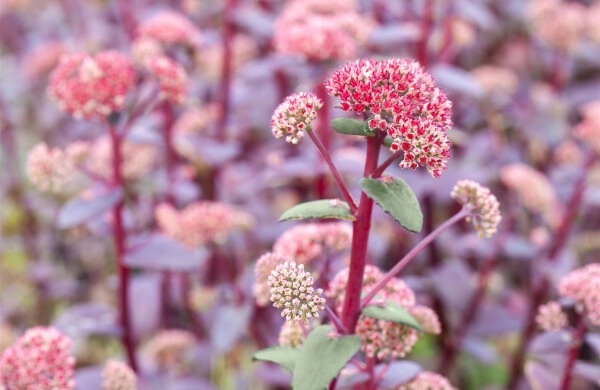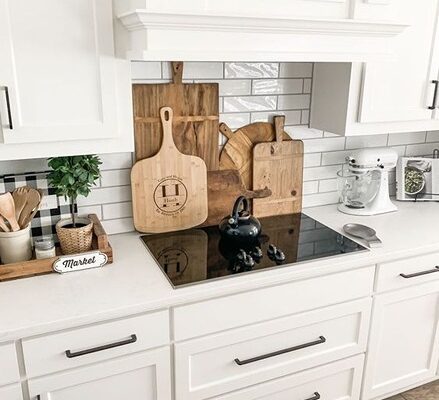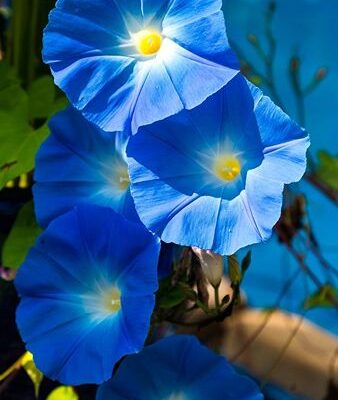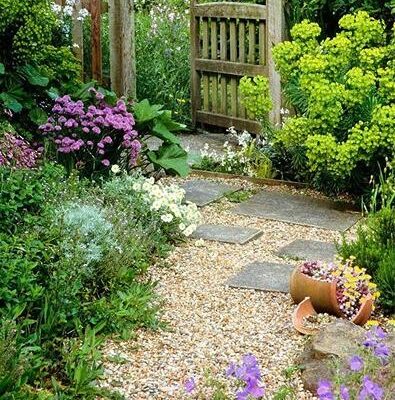15 Stunning Sedum Plants for Heat and Cold
A wide range of sedum plants types provide an array of colors and sizes to complement your garden. Enhance water conservation in your garden using the exquisite sedums plants, commonly referred to as stonecrops. These resilient plants, known for their ability to withstand drought, come in a multitude of shapes, colors, and sizes. Whether you desire a creeping sedum plants for groundcover or an upright sedum that attracts bees and butterflies, these sedum variations showcase exceptional leaf colors, flowers, and overall forms.

1. Angelina
Sedum ‘Angelina’ is a remarkable and low-maintenance groundcover that never fails to captivate, despite its compact size. This sedum variety boasts stunning bright golden foliage that undergoes a striking transformation, turning into a vibrant orange hue during the fall season. Adding to its charm, ‘Angelina’ produces star-shaped yellow flowers in the summer. This sedum thrives when allowed to drape over stone walls, making it an excellent choice for creating a visually appealing vertical display. Additionally, it serves as a perfect addition to succulent container gardens or hanging baskets, where its trailing growth habit can be fully appreciated.
Scientifically known as Sedum rupestre ‘Angelina’, this plant flourishes in growing conditions that offer full sun exposure and well-drained soil. Reaching a modest height of up to 4 inches, ‘Angelina’ sedum is a versatile option for filling in gaps or adding a touch of vibrancy to various garden settings. It is most suitable for planting in USDA hardiness zones 5 to 8, where it can thrive and add a burst of golden beauty to your outdoor space. Embrace the striking foliage and charming flowers of Sedum ‘Angelina’ by incorporating it into your garden or container displays.

2. Autumn Joy
Autumn Joy sedum is a timeless and beloved perennial that brings a splash of color to your yard throughout the seasons. From spring to fall, this sedum variety showcases its beauty with large clusters of tiny, star-shaped flowers. These flowers emerge in a delightful pink shade during late summer, attracting a wide array of pollinators to your garden. As the season progresses, the blooms transform into a rich and deep rose-red hue, eventually maturing into a captivating coppery-rust color in autumn. Complementing the vibrant blooms, the sedum’s gray-green succulent leaves maintain a lush appearance throughout the summer.
Scientifically referred to as Hylotelephium ‘Herbstfreude’, this sedum thrives in growing conditions that provide full sun exposure and well-drained soil. It can reach a height of up to 2 feet, creating an impressive presence in your garden. Autumn Joy sedum is well-suited for planting in USDA hardiness zones 3 to 9, showcasing its adaptability to various climates. Embrace the enduring appeal of Autumn Joy sedum by incorporating it into your garden, and revel in its stunning flowers, captivating foliage, and the multitude of pollinators it attracts throughout the seasons.
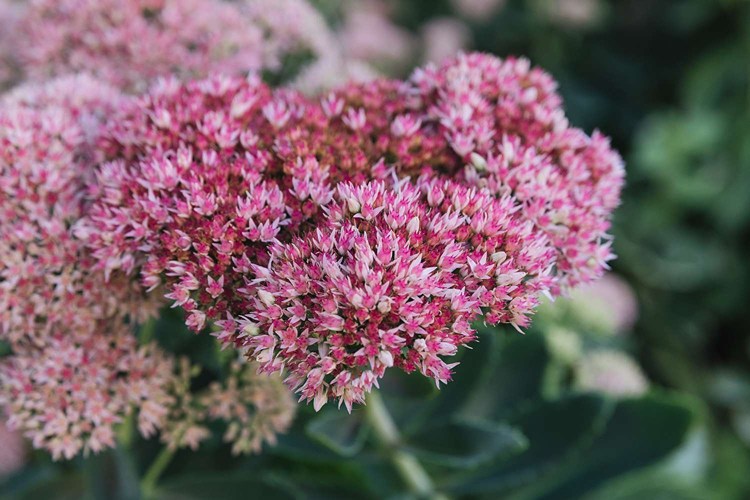
3. Blue Spruce
Blue Spruce sedum is a remarkable sedum variety that stands out with its striking silvery-blue hue and needle-like leaves, making it an exceptional choice for border fronts or rock gardens. Adding to its allure, this sedum produces vibrant yellow star-shaped flowers that emerge during the summer season, enhancing the visual appeal of the plant. Notably, Blue Spruce sedum is a drought-resistant perennial that possesses the unique ability to thrive in clay soil, setting it apart from many other sedum varieties.
Scientifically known as Sedum ‘Blue Spruce’, this sedum thrives in growing conditions that offer full sun exposure and well-drained soil. Reaching a maximum height of 9 inches, Blue Spruce sedum is a compact and versatile plant that can make a significant impact in various garden settings. It is well-suited for planting in USDA hardiness zones 3 to 9, showcasing its adaptability to a wide range of climates. Embrace the captivating beauty and resilience of Blue Spruce sedum by incorporating it into your garden, and enjoy its silvery-blue foliage, cheerful flowers, and ability to thrive in challenging clay soil conditions.

4. Broadleaf Stonecrop
Broadleaf stonecrop, scientifically known as Sedum spathulifolium, is a robust and sprawling plant that exhibits vigorous growth, quickly overtaking and suppressing weeds in its vicinity. This hardy succulent showcases striking silvery foliage and blooms with cheerful yellow flowers during the summer season. An ideal addition to your rock garden, broadleaf stonecrop is a native plant that thrives on the face of cliffs in northern California, adding a touch of authenticity to your landscape.
To ensure optimal growth, broadleaf stonecrop requires growing conditions that provide sun to partial shade exposure and well-drained soil. It reaches a modest height of up to 4 inches, making it a versatile choice for filling in gaps or creating a low-lying carpet effect in your garden. Broadleaf stonecrop is well-suited for planting in USDA hardiness zones 5 to 9, where it can flourish and contribute to the visual appeal of your outdoor space. Embrace the natural beauty and resilience of this native succulent by incorporating it into your garden design.
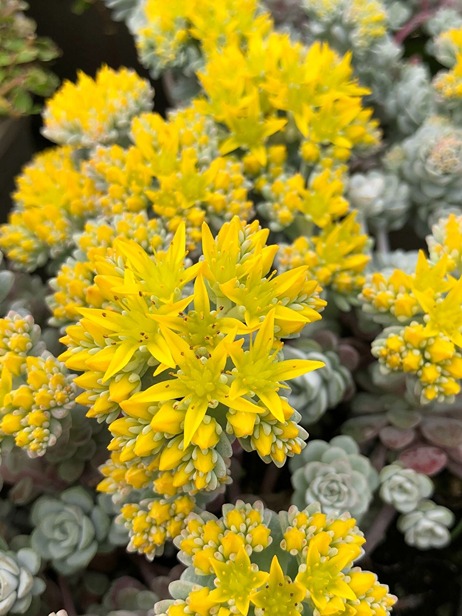
5. Dragon's Blood Sedum
Dragon’s Blood sedum is a highly sought-after groundcover that is favored among gardening enthusiasts. This evergreen sedum variety showcases captivating deep purple foliage that transitions into a striking shade of red as the fall season approaches. Adding to its allure, Dragon’s Blood sedum produces clusters of pinkish-purple flowers that bloom from midsummer all the way into autumn. With its visually stunning characteristics, this sedum variety is a perfect choice for planting in border fronts, sloped areas, or even containers, adding beauty to any desired location.
Scientifically known as Sedum spurium ‘Dragon’s Blood’, this sedum thrives in growing conditions that offer full sun exposure and well-drained soil. It typically reaches a height of up to 6 inches, making it a compact and versatile groundcover option for various garden settings. Dragon’s Blood sedum is most suitable for planting in USDA hardiness zones 4 to 9, ensuring its adaptability across a wide range of climates. Embrace the enchanting beauty of Dragon’s Blood sedum by incorporating it into your garden, and enjoy the deep purple foliage and vibrant flowers it offers throughout the seasons.

6. Sedum Frosty Morn
Sedum ‘Frosty Morn’ is a captivating variegated sedum variety that is sure to catch the eye. With its tall stems and generously sized, spoon-shaped leaves, this sedum offers a visually striking presence in any garden. The foliage of ‘Frosty Morn’ showcases a pleasing combination of sage green coloration with crisp white borders, adding a touch of elegance to borders or containers. As the seasons transition to late summer and early fall, this sedum bursts into bloom, adorning itself with clusters of stunning pink and white flowers.
Scientifically known as Sedum erythrostictum ‘Frosty Morn’, this sedum variety thrives in growing conditions that include full sun exposure and well-drained soil. It can reach a height of up to 12 inches, making it a medium-sized plant suitable for various garden settings. ‘Frosty Morn’ is most suited for planting in USDA hardiness zones 3 to 9, where it can flourish and enchant with its distinctive foliage and charming flowers. Consider adding this sedum to your garden for an eye-catching and beautiful addition to your outdoor space.
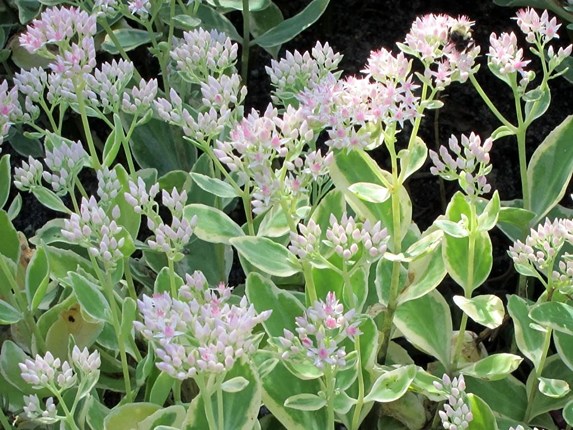
7. John Creech
Renowned for its diminutive and finely textured foliage, ‘John Creech’ sedum is a cherished plant that rapidly spreads to create a dense mat with its creeping stems. Adding to its allure, this sedum variety produces delicate pink flowers that emerge above the foliage during the autumn season. While commonly grown as a groundcover, ‘John Creech’ sedum is versatile and finds utility in various garden settings. It can be employed as border fronts, nestled within stone wall pockets, utilized on slopes, employed as edging, or even placed in containers, providing endless possibilities for incorporating this sedum into your landscape.
Scientifically known as Sedum spurium ‘John Creech’, this sedum thrives in growing conditions that offer full sun exposure and well-drained soil. Reaching a maximum height of only 2 inches, ‘John Creech’ sedum is a low-growing plant that creates a compact and visually pleasing presence in the garden. It is most suited for planting in USDA hardiness zones 3 to 8, ensuring its adaptability across a range of climates. Embrace the versatility and charm of ‘John Creech’ sedum by incorporating it into your garden, and enjoy its small foliage, delicate flowers, and the multitude of uses it offers in various garden designs.
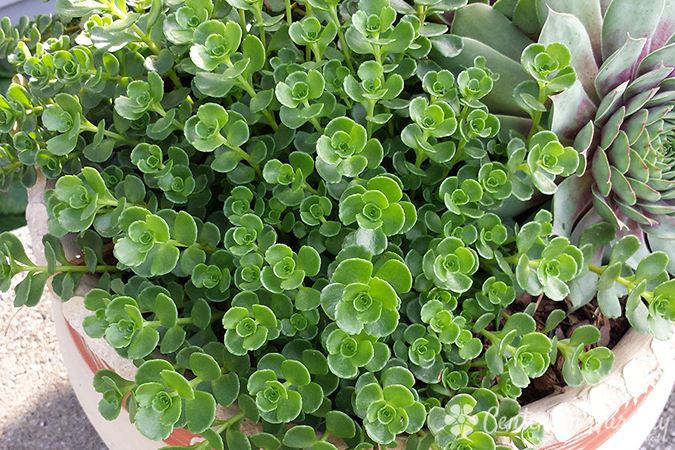
8. Sedum kamtschaticum
Sedum kamtschaticum, originating from Siberia, is a remarkable plant that deserves recognition despite its lengthy name. This beautiful groundcover exhibits deep green leaves and blooms with radiant golden-yellow flowers during the late summer season. To thrive, Sedum kamtschaticum requires abundant sunlight. Providing it with brighter light intensities not only enhances the richness of the leaf colors but also promotes more abundant and vibrant flowering.
Scientifically known as Sedum kamtschaticum, this plant flourishes in growing conditions that offer full sun exposure and well-drained soil. Reaching a height of up to 6 inches, this sedum variety is a compact and versatile choice for various garden settings. It is ideally suited for planting in USDA hardiness zones 3 to 8, where it can thrive and display its captivating foliage and cheerful flowers. Discover the beauty of Sedum kamtschaticum by incorporating it into your garden and providing it with the sunlight it craves.
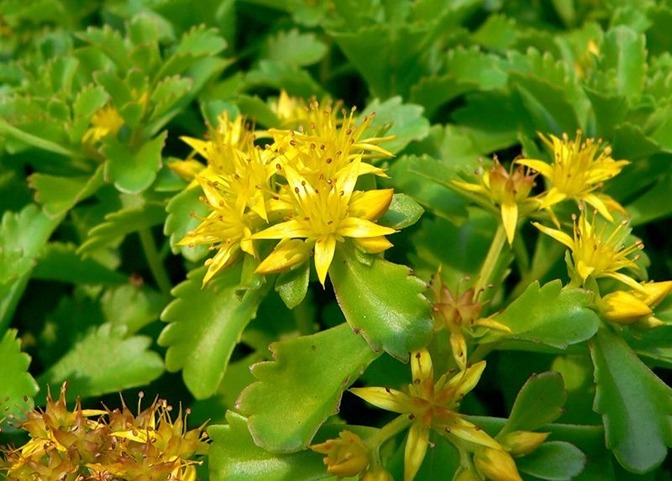
9. Moss Stonecrop
Known as moss stonecrop, this evergreen plant adds a touch of charm to any landscape with its unique characteristics. It features dark green leaves with a finely textured appearance, providing an attractive backdrop for the plant’s yellow flowers that bloom during the summer season. The moss stonecrop, scientifically referred to as Sedum acre, is a low-growing perennial that forms a dense carpet-like growth. It not only serves as a decorative element but also acts as a walkable groundcover, capable of withstanding light foot traffic. Consider incorporating this versatile plant along border fronts, in rock gardens, along walkways, or atop rock walls to enhance the visual appeal of these areas.
To ensure optimal growth, moss stonecrop thrives in full sun exposure and requires well-drained soil. Reaching a modest height of up to 3 inches, this sedum variety is a perfect choice for those seeking a compact and low-maintenance plant. It is ideally suited for planting in USDA hardiness zones 3 to 8, offering a versatile and resilient addition to various garden settings.
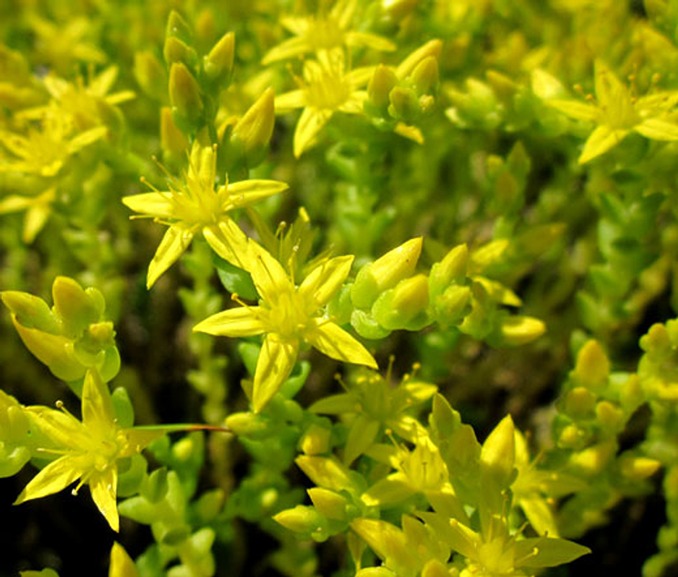
10. October Daphne Stonecrop
October Daphne stonecrop, scientifically referred to as Sedum sieboldii, is a visually captivating plant with its delicate features. This sedum variety showcases finely textured blue-green leaves that are adorned with a striking deep pink line along the edges. Adding to its allure, October Daphne stonecrop produces charming pink flowers that attract bees and butterflies, making it an excellent choice for pollinator gardens.
To ensure optimal growth, October Daphne stonecrop thrives in growing conditions that include full sun exposure and well-drained soil. It can reach a height of up to 12 inches, making it a medium-sized plant that can stand out in various garden settings. Suitable for planting in USDA hardiness zones 3 to 9, this sedum variety offers both beauty and ecological benefits by attracting pollinators to your garden. Consider incorporating October Daphne stonecrop into your landscape to enjoy its elegant foliage and vibrant flowers.
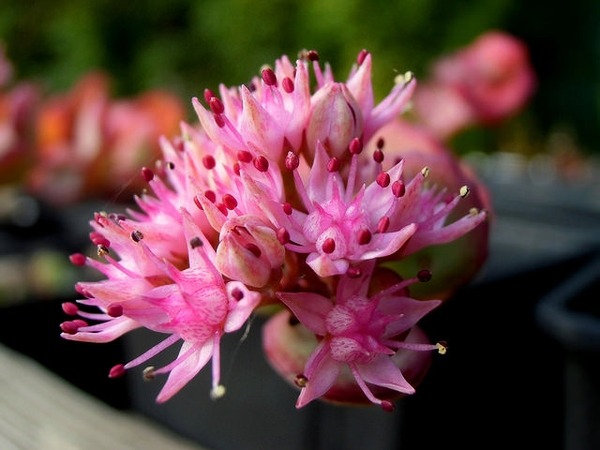
11. Sedum Ogon
Sedum ‘Ogon’ is a highly desirable groundcover known for its striking bright gold foliage. This particular sedum variety is not only visually captivating but also incredibly low-maintenance, making it a popular choice among gardeners. While ‘Ogon’ does produce tiny yellow-green flowers during the summer season, it is the foliage that steals the show. The vibrant golden leaves take center stage, overshadowing the blooms in terms of visual impact. For an extra dose of allure, consider incorporating ‘Ogon’ in your succulent container garden, where its small leaves can elegantly cascade over the edges, adding a beautiful touch to the arrangement.
Scientifically referred to as Sedum makinoi ‘Ogon’, this groundcover thrives in growing conditions that include full sun to part shade exposure and well-drained soil. It reaches a modest height of up to 2 inches, making it an excellent choice for filling in spaces or creating a dense carpet-like effect in your garden. ‘Ogon’ sedum is most suitable for planting in USDA hardiness zones 6 to 9, where it can flourish and provide a vibrant, golden accent to your outdoor space.
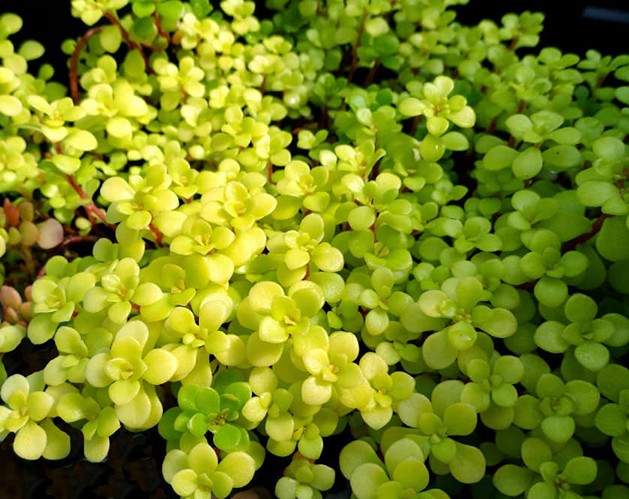
12. Purple Emperor
The captivating hybrid perennial sedum known as ‘Purple Emperor’ boasts striking features. Its deep purple, succulent leaves are complemented by delightful clusters of small, pink, star-shaped flowers that bloom during the summer season. These vibrant flowers serve as a magnet for various pollinators, including bees, butterflies, and other buzzing insects. ‘Purple Emperor’ sedum exhibits an upright to slightly spreading growth habit, forming attractive clumps that persist from summer to fall.
When it comes to its cultivation, Sedum ‘Purple Emperor’ thrives best in full sun exposure and well-drained soil. It reaches a height of up to 15 inches, making it a modest-sized plant for your garden. Suitable for planting in USDA hardiness zones 3 to 7, this sedum variety offers an eye-catching addition to your landscape.
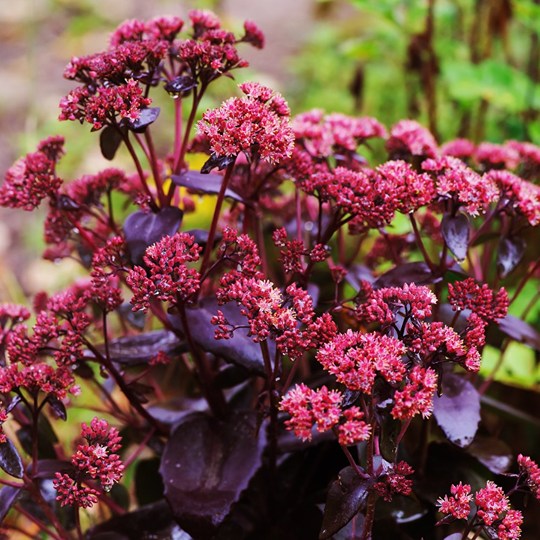
13. Showy Stonecrop
Originating from Japan, the showy stonecrop, scientifically known as Sedum cauticola, presents an exquisite display with its distinct features. Its leaves are adorned with a captivating combination of blue-green coloration and purple edges, while its late summer blooms showcase charming pinkish-purple hues. This sedum variety boasts a profusion of flowers, making it a visually stunning addition to any garden. Whether showcased as a standalone plant or utilized as a groundcover beneath taller sun-loving perennials, the showy stonecrop adds a touch of elegance to the landscape.
To ensure optimal growth, the showy stonecrop thrives in full sun exposure and requires well-drained soil. This compact sedum reaches a height of up to 4 inches, making it a petite but impactful presence in the garden. It is ideally suited for planting in USDA hardiness zones 5 to 9, where it can thrive and enchant with its remarkable beauty.
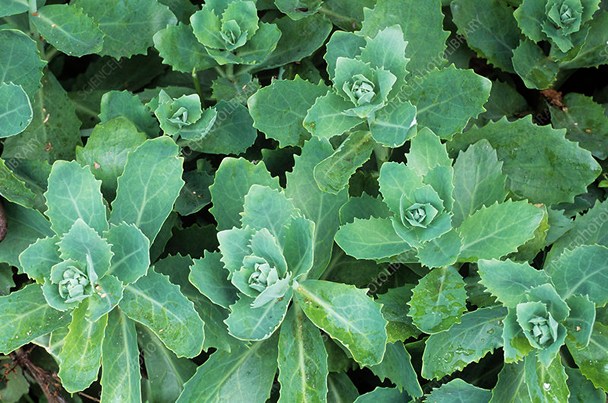
14. Tricolor
Enhance the vibrancy of your rock garden or borders with the captivating Sedum ‘Tricolor’. This sedum variety offers a delightful burst of color, with each green leaf delicately edged in shades of pink and white. As late spring arrives, star-shaped pink flowers emerge, adorning the plant until midsummer. One of the notable characteristics of this sedum is its ease of propagation through division and cuttings, allowing you to propagate and enjoy even more of this eye-catching variety.
Scientifically known as Sedum spurium ‘Tricolor’, this sedum thrives in growing conditions that provide full sun exposure and well-drained soil. It can reach a height of up to 6 inches, making it a compact and versatile plant suitable for various garden settings. ‘Tricolor’ sedum is ideally suited for planting in USDA hardiness zones 3 to 9, ensuring its adaptability across a range of climates. Embrace the vivid colors and propagation ease of Sedum ‘Tricolor’ by incorporating it into your garden, and revel in its striking foliage and charming flowers throughout the seasons.
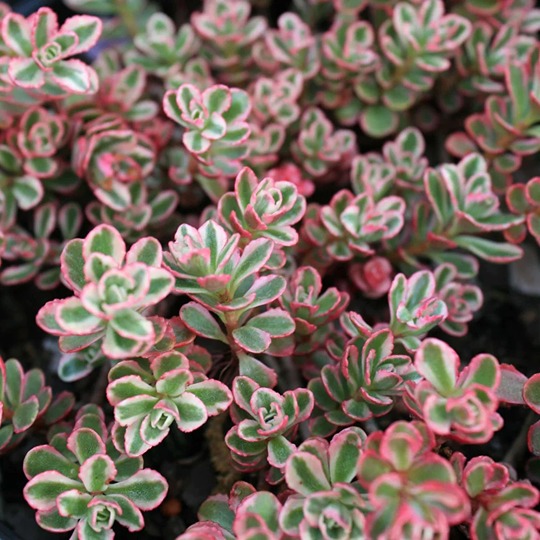
15. Vera Jameson
Sedum ‘Vera Jameson’ is a captivating clump-forming sedum variety that effortlessly complements various garden designs. Its standout features include its vibrant purple foliage and eye-catching pink flowers, which contribute a wealth of color and texture to the garden throughout the entire season.
Scientifically referred to as Sedum ‘Vera Jameson’, this sedum variety thrives in growing conditions that provide full sun exposure and well-drained soil. It can reach a height of up to 12 inches, making it a medium-sized plant that can make a significant impact in your garden. ‘Vera Jameson’ sedum is well-suited for planting in USDA hardiness zones 3 to 9, ensuring its adaptability to a wide range of climates. Embrace the visual appeal and versatility of Sedum ‘Vera Jameson’ by incorporating it into your garden, and enjoy its stunning purple foliage and delightful pink flowers throughout the seasons.
